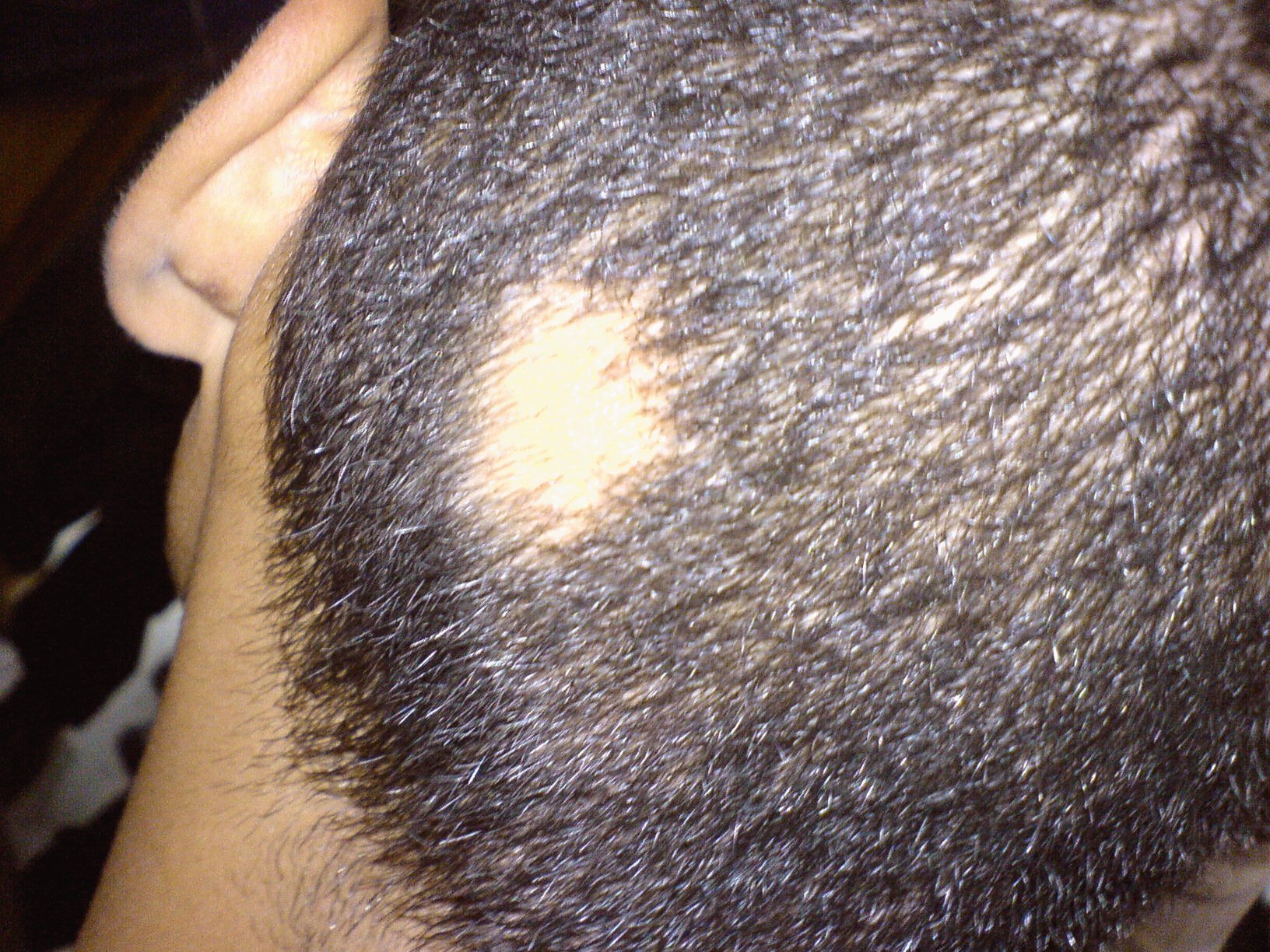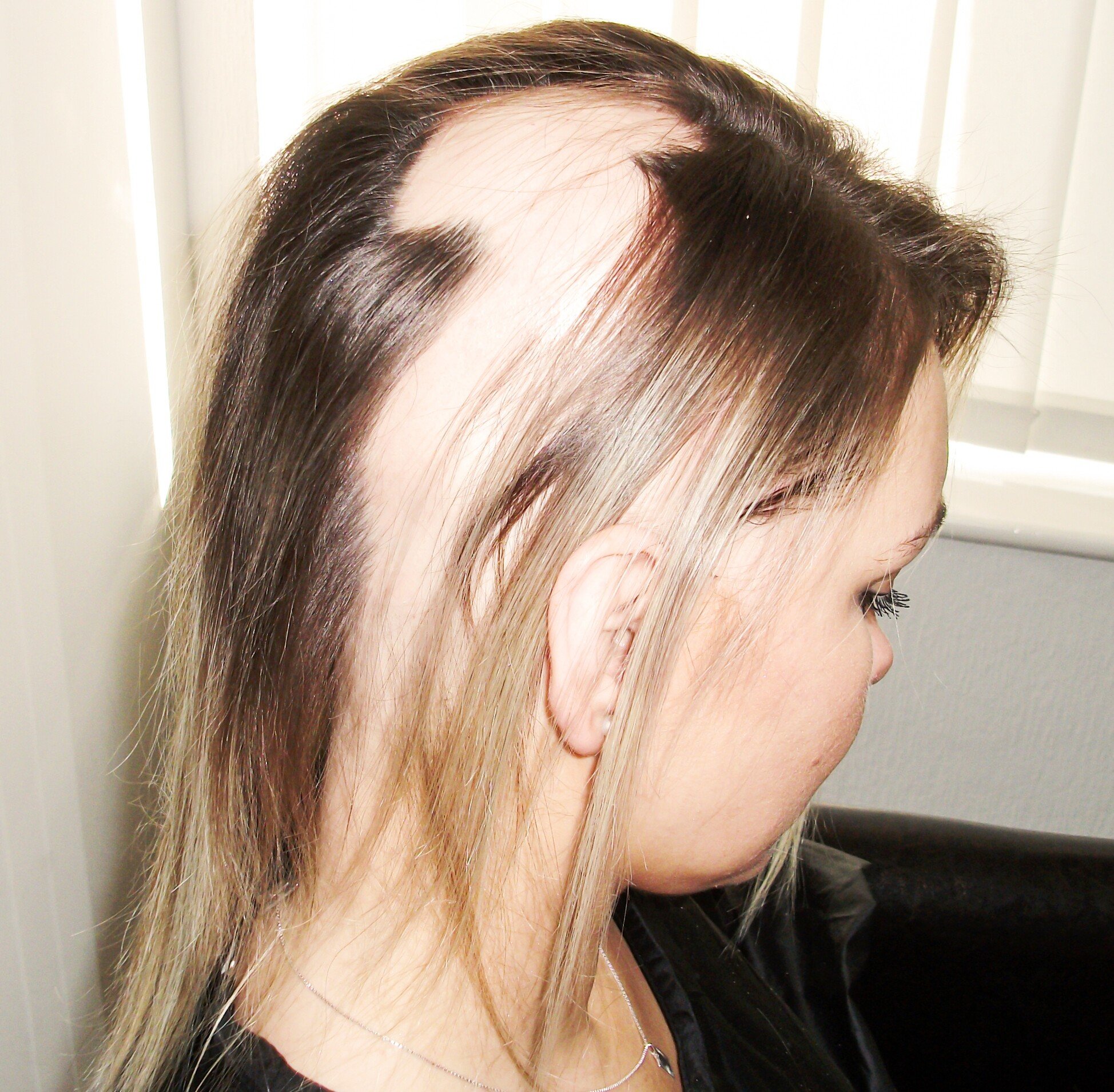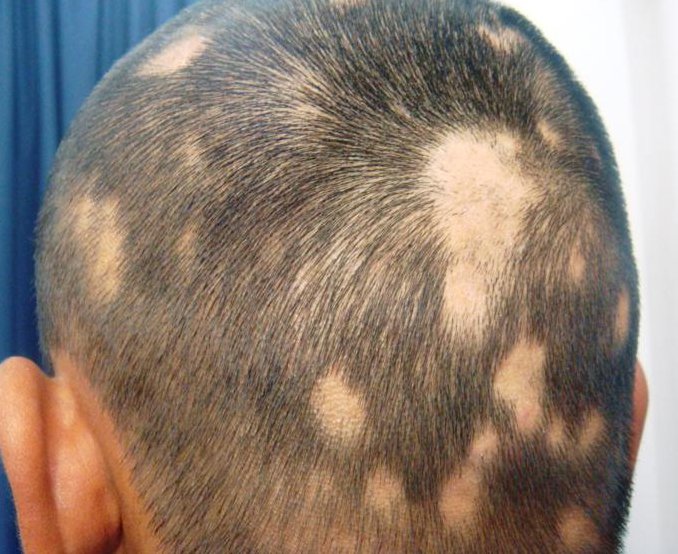What Kinds Of Symptoms Will I Have With Alopecia Areata
All types of alopecia areata result in some form of hair loss. There is no way to predict the pattern of hair loss and regrowth you will experience or how severe or long lasting it will be. Its important to remember that alopecia areata is different for everyone who has it.
Still, there are some common symptoms of alopecia areata that are good to know and recognize. However, the only way to be sure you have alopecia areata is to make an appointment and get a diagnosis from a doctor.
Symptoms of alopecia areata may include
- Small, round patches of hair loss on the scalp, beard area of the face or other areas of the body with hair
- Hair loss and regrowth at the same time in different areas of the body
- Significant hair loss in a very short period of time
- Hair loss thats mostly on one side of the scalp, instead of both sides
- Exclamation point hairs that are narrow at the base/next to the scalp
- Stippling or Pitting on the fingernails
What Is The Outlook For People With Alopecia Areata
- Thankfully, mild cases of alopecia areata often get better without treatment within a few months to a year.
- In some cases, patchy baldness may come and go over many months or years. The size of the bald patch or patches and how long they last are quite variable.
- If less than half of the scalp is affected and no treatment is started, there is about an 80% chance of full hair regrowth within one year.
- With more extensive hair loss, it is less likely that hair will regrow.
However, even if your hair grows back fully after an episode of alopecia areata, it is common to have one or more recurrences of the condition throughout your life. A few people who develop alopecia areata will progress to total scalp baldness . Even fewer people will lose all scalp and body hair . Progression to these more extensive types of hair loss is more common if:
- The bald patches start in childhood.
- The initial bout of hair loss affects more than half of your scalp.
- You have another autoimmune disease.
Treatment can promote hair regrowth in some cases.
Alopecia Areata In Males
Alopecia areata occurs in both men and women, but the loss of hair is likely to be more significant in men. Men are also more likely to have a family history of the hair loss condition.
Men may experience hair loss in their facial hair, as well as their scalp, chest, and back hair. Compared to male-pattern baldness, which is a gradual thinning of hair all over, hair loss from this condition causes patchy hair loss.
Also Check: Can You Go To A Dermatologist For Hair Loss
What Is Alopecia Areata
This is a disease that develops when the body attacks its own hair follicles , which can cause hair loss anywhere on the body.
Contagious: No
Pronounce: alopecia areata
Bald patch
Many people who develop alopecia areata develop a round or oval bald patch on their scalp.
Many people who develop alopecia areata are otherwise healthy. They have hair loss and sometimes nail changes, but they remain in good health.
The hair loss tends to be unpredictable. Hair may regrow without treatment. This happens more often when someone has a few bald patches. When the hair regrows, it may fall out againor it may not.
If alopecia areata affects the nails, you may see dents, ridges, or brittle nails. Some people develop red nails.
Is There A Test For Alopecia Areata

There is no single test to tell you if you have alopecia areata. Doctors usually see if you have the disease by:
- Looking at the areas where the hair has been lost and at your nails.
- Looking at your hair and hair follicle openings.
- Asking about your medical and family history.
- Ordering blood tests or other lab tests.
Don’t Miss: Where To Buy Thinning Shears For Hair
Alopecia Universalis: One Type Of Hair Loss Explained
Hair loss may seem like a singular event and an unsettling one at that. But beyond the primary visible loss of hair down at the level of our follicles and the bodily systems that impact them the causes of hair loss can be quite complex and varied.
What is alopecia universalis? How is it treated, and is it reversible? Read on to unpack this particular type of hair loss, including what you might expect with this condition, expert tips for managing alopecia universalis.
Points To Remember About Alopecia Areata
- Alopecia areata causes hair loss, usually on the head and face.
- The disease is different for each personsome peoples hair grows back fully, while it does not in others.
- There is no cure for alopecia areata, but there are treatments that help hair grow back more quickly.
- You can do many things to cope with hair loss, such as wearing hats or hair pieces and seeking support from others if you feel anxiety or depression.
Read Also: Is There Any Treatment For Hair Loss
How Do Dermatologists Treat Alopecia Areata
If you just received your diagnosis and have had alopecia areata for less than a year, your dermatologist may recommend a wait-and-see approach. Your hair may regrow on its own, making treatment unnecessary.
When treatment becomes necessary, your dermatologist will consider many factors, including:
-
Your age
-
The amount of hair loss you have
-
Where you have hair loss
Its important to know that no one treatment works for everyone. To find one that helps, you may need to try a few types of treatment or different medications. Heres what your dermatologist may recommend.
Types Of Alopecia Areata
When talking about treatment, your dermatologist may mention the type of alopecia areata that you have.
The main types are:
Alopecia areata: Alopecia is the medical term for bald. Areata means patchy. This patchy baldness can develop anywhere on the body, including the scalp, beard area, eyebrows, eyelashes, armpits, inside your nose, or ears.
Alopecia totalis: The person loses all hair on the scalp, so the scalp is completely bald.
Alopecia universalis: The person loses all hair, leaving the entire body hairless. This is rare.
You can see pictures of some ways that alopecia areata can affect the scalp, eyelashes, and nails at: Alopecia areata: Signs and symptoms.
ImageImage used with permission of the American Academy of Dermatology National Library ofDermatologic Teaching Slides.
ReferencesHan G. The changing landscape of alopecia areata: An introduction. Adv Ther. 2017 34:1584-5.
Korta DZ, Christiano AM, et al. Alopecia areata is a medical disease. J Am Acad Dermatol. 2018 78:832-4.
Putterman E, Castelo-Soccio L. Seasonal patterns in alopecia areata, totalis, and universalis. J Am Acad Dermatol 2018 78:1-12.
Renert-Yuval Y, Guttman-Yassky E. The changing landscape of alopecia areata: The therapeutic paradigm. Adv Ther. 2017 34:1594-1609.
Sperling LC. Alopcias. In: Bolognia JL, et al. Dermatology. . Mosby Elsevier, Spain, 2008:993-3.
Also Check: How Long Does Hair Loss Last After Giving Birth
Causes Of Alopecia That You Probably Didnt Know
Alopecia is, simply put, hair loss. If you have alopecia, you might see extra hair on pillows or in shower drains, or you might notice bald patches on your scalp. Over time hair loss can grow back or fall out permanently, depending on the cause. Alopecia is not curable, but it’s treatable and not life-threatening.
Here are some of the possible causes of alopecia.
What Are The Risk Factors For Alopecia Areata
Most, if not all, people with alopecia areata have a genetic predisposition to the condition. There may be environmental triggers, but this is not entirely clear. Alopecia areata affects men and women similarly and has no known predilection for any ethnic group, says dermatologist Brett King, MD. It typically develops in the first 4 decades of life, but it can also arise later in life.
Recommended Reading: Can Fleas Cause Hair Loss In Cats
Children 10 Years Of Age And Younger
Alopecia areata often begins during childhood. If your child has difficulty coping with the hair loss, treatment can often help regrow hair.
Treatment options for children 10 years of age and younger are:
-
Corticosteroid you apply to the bald spots: Prescription-strength corticosteroids can help regrow hair. You apply this medication once or twice a day. For children, this alone can be an effective treatment.
-
Minoxidil: Also known by the brand name Rogaine®, minoxidil can help maintain the regrowth after you stop applying the corticosteroid. It has few side effects, so its considered a good option for children.
For children older than 10 years of age, treatment options are based on the amount of hair loss.
How Is It Diagnosed

Alopecia universalis may be diagnosed with a physical exam and other medical tests. A healthcare professional or dermatologist may be able to diagnose the condition with a medical history and by checking for loss of hair throughout the body.
Sometimes a doctor will recommend a biopsy to confirm the disease and to check for other skin conditions. They may also order blood tests to look for other health problems.
The National Institutes of Health say no therapy has been found to cure this condition. The treatment chosen often depends upon a persons age, medical history, and severity of their hair loss.
Though there is no reliable treatment, some medications that may work include:
- Diphenylcyclopropenone: A topical drug that has been successful in treating alopecia areata in some people.
- Squaric acid dibutylester: This is also used to treat alopecia areata.
- Steroids: These help calm down the immune response and inflammation.
- Cyclosporine: An immunosuppressive drug, in combination with a steroid called methylprednisolone.
You May Like: How To Curl Thin Hair
Treatment For Hair Loss
Most hair loss does not need treatment and is either:
- temporary and it’ll grow back
- a normal part of getting older
Hair loss caused by a medical condition usually stops or grows back once you’ve recovered.
There are things you can try if your hair loss is causing you distress. But most treatments are not available on the NHS, so you’ll have to pay for them.
No treatment is 100% effective.
What Are The Common Causes Of Hair Loss In Women
What causes hair loss?
- Hair style: Your style of hair can cause hair loss when your hair is arranged in ways that pull on your roots, like tight ponytails, braids, or corn rows. This type of hair loss is called traction alopecia. If hair follicles are damaged, the loss can be permanent.
- Vitamin deficiency.
- Over processed scalp hair .
What causes anagen effluvium hair loss?
- Toxic substances, including chemotherapy, radiation therapy and some medications. These cause sudden hair loss that can occur anywhere on your body. It happens to hair in the growth stage. Sometimes, this type of hair loss can be permanent if your hair follicles are damaged.
What causes telogen effluvium hair loss?
- Extreme physical stress or shock to your body: This causes temporary hair loss. This category includes events like losing a lot of weight, surgery, anemia, illness and having a baby.
- Extreme emotional stress: mental illness, the death of a loved one, etc.
- An abnormal thyroid.
- Medications and supplements: blood pressure medicines, gout medicines and high doses of Vitamin A.
- Hormone changes caused by pregnancy, menopause or birth control pills.
What causes FPHL ?
- Genes: Your familys genes can cause thinning of hair along the top of your head.
- Aging: Hormone changes as you age can cause balding.
- Menopause: This type of hair loss often gets worse when estrogen is lost during menopause.
There are also some conditions that affect hair loss:
Don’t Miss: How To Help Pcos Hair Loss
What Is Alopecia And What Causes It
Alopecia is a condition that causes people to lose hair from a single area or from multiple areas of their head, face or body.
The most common types are:
- male pattern baldness
- female pattern baldness
- alopecia areata
Less commonly, hair loss can be caused by medicines , medical conditions, or psychological conditions.
Research Leading To New Treatment
Because hair loss can greatly affect a persons quality of life, researchers continue to study alopecia areata. Much of this research focuses on developing more effective treatments. This is giving new hope to patients, especially those living with widespread hair loss.
Dermatologists are conducting much of this research. If you are an adult with widespread alopecia areata, your dermatologist may talk with you about the possibility of joining one of these studies.
You May Like: How Do You Treat Thinning Hair
How Common Is Hair Loss In Women
Many people think that hair loss only affects men. However, it is estimated that more than 50% of women will experience noticeable hair loss. The most significant cause of hair loss in women is female-pattern hair loss , which affects about one-third of susceptible women, which equals out to some 30 million women in the United States.
Complications Of Alopecia Areata
Alopecia may be temporary or persistent. More severe and persistent disease increases the chance that alopecia areata will cause psychosocial consequences of their disease, such as depression and anxiety.
Patients should be assessed for atopy, vitiligo, thyroid disease, and other autoimmune conditions.
Don’t Miss: How To Style Mens Thin Hair
Alopecia Totalis Vs Alopecia Universalis
Alopecia totalis is a different, less severe form of alopecia areata as compared to alopecia universalis. While AU is characterized by a loss of all body hair, alopecia totalis is contained to hair loss on the entire scalp. Alopecia totalis, which can include a near-total or total loss of hair on the scalp, can worsen and become alopecia universalis. The key difference between the two is the severity of hair loss, though they are both caused by a autoimmune disease.
Preventive And Minimization Strategies

Hair, especially in Asian and Caucasian individuals, is generallymore elastic when wet, which means that it breaks more easily than whendry. Therefore, it is important to avoid rubbing wet hair with a toweland brushing or combing wet hair. Allowing hair to air dry rather thanusing a blow-dryer also may be beneficial, because high heat renders thehair brittle and more prone to breakage. Similarly, limiting the use offlat irons and curling irons can also help prevent hair loss.1
Certain products and hairstyles put stress on the hair and cause itto break. Limiting the use of bleaches, dyes, gels, relaxers, and hairsprays can help reduce breakage. Hairpins, clips, and rubber bands cancause breakage when used to hold hair tightly. If these accessories areused, the best choices are hairpins that have a smooth, ball-tippedsurface, hair clips with a spongy rubber padding, and hair bands made offabric. To prevent breakage, hairstyles that pull on the hair, such ascornrows, tight ponytails, and braids, should be avoided.1
You May Like: What Is The Best Organic Shampoo For Thinning Hair